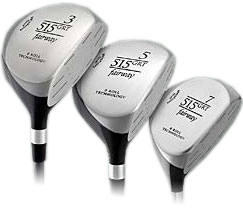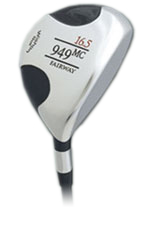DESIGN FIRSTS
FAIRWAY WOODS
First 0.830 COR FAIRWAY WOODHEAD
2004 – Wishon Golf 515GRT Fairway Woods

In 2004 Wishon Golf elevated its expertise in woodhead face design by creating the 515GRT, the first fairway woods to reach the USGA’s 0.830 COR/257 CT limit.
It was believed to be impossible to create a fairway wood with a 0.830 COR because fairway woods have a much smaller size face than a driver. The larger the face, the easier it is to design the face to flex inward enough to achieve a high COR. But the smaller the face, the more difficult this is to do because smaller faces cannot flex inward as much as will a larger face. The vast majority of people in the golf industry felt that if you kept making the fairway wood face thinner and thinner to get it to flex inward enough to create a high COR, the faces would break or cave in before you ever got to the higher COR level of performance. When the USGA adopted the limit on COR in 1998, the rule was originally created to apply only to clubheads with a loft of 15* or less. This meant the USGA also believed high COR was the exclusive domain of drivers.
Wishon Golf achieved its high COR fairway wood face breakthrough by combining a forged cup-face construction with a vertically flat zero roll face using a high strength steel alloy from Carpenter Steel called Tour Alloy 275. Interestingly, the very first prototypes made for hit testing showed that the 515 #3-wood had a measured COR of 0.843 with the 5-wood prototype at 0.836″ – both actually higher than the USGA limit established for drivers. In fact the 515GRT woods were responsible for the USGA changing the spring face rule to include clubheads other than drivers. With that change in the rule, the faces of the 3- and 5-wood had to be thickened slightly for the production of the heads to get their COR back down to the conforming limit.
First Shallow Face Fairway Woods with 0.830 COR
2007 – Wishon Golf 949MC Woods

With the introduction of the 515GRT woods, Wishon Golf was the first company to introduce a fairway wood design which achieved the 0.830 COR limit imposed by the USGA. Previously, it had been felt that the much smaller face height and face area of typical fairway woods prevented the face from being able to flex inward enough to achieve such a high COR. In 2007, TWGT went one step further by designing a set of woods with a more shallow face height than the 515GRT woods that still had a COR of 0.830.
The face height of the 515GRT woods was designed to be 36mm tall. For skilled players, this is not a face height that is difficult to hit the ball well up in the air off a normal fairway lie. But for average to less skilled golfers, a fairway wood with a 36mm face height can look too tall and can bring about a lack of confidence in the golfer’s mind that can affect their ability to easily get the ball up high enough to achieve maximum carry distance for normal fairway lies. Thus the 515GRT was not a model that average to less skilled players could take advantage of to gain an increase in distance from the high COR face.
Trying to create a high COR fairway wood model for all levels of players is the concept that drove Tom to determine if it was possible to push the envelope of small face/high COR design and create a fairway wood with a shorter face height that still could achieve the maximum COR at the maximum allowed by the Rules of Golf.
This breakthrough in fairway wood design was facilitated by the use of a totally custom formulated higher strength steel alloy named HS300 to enable the faces of the 949MC to be made thinner than the faces of the 515GRT but still durable enough to withstand a clubhead speed up to 125mph without failing. With their 32mm face height, the 949MC fairway woods offer golfers a completely unique performance combination of a more shallow face for easier playability but still with maximum COR for more distance.
First Fairway Woods with a Bendabl Hosel for Changing Lie and Face Angle
2011 – Wishon Golf 929HS Fairway Woods

Another clubhead design breakthrough that originated from Tom Wishon’s commitment to full specifications custom clubfitting was the bendable hosel that debuted in 2011 on Wishon Golf’s 929HS fairway woods and continued on virtually every fairway wood model Tom designed after the 929HS.
Prior to the 929HS woods, virtually all fairway woods were manufactured by investment casting the body, face and hosel as one piece, all made from the same alloy. Since high strength, low ductility steel alloys have been the vastly predominant choice for fairway wood construction since the introduction of metal woods in the 1980s, no fairway wood was able to be bent to significantly customize the lie and or face angle. At best a conventional investment cast stainless steel fairway wood was only able to be pushed for a 1* change in the lie or face angle.
The secret to the > +/-4* bending capability of the 929HS woods was the change to a 4 piece construction method. By forming the crown, sole/skirt, face and hosel pieces separately to be welded together to form the head, Wishon could choose a soft 304 grade stainless steel alloy to make the hosel fully bendable. While Wishon Golf states a limit of +/-4* for bending the hosel of the 929HS woods, experienced clubmakers are able to push the hosel more than that when more extreme lie and face angle alterations are necessary to help the golfer play better.

